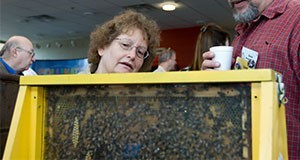Abstract
The use of observation bee hives continues to interest a variety of people. This is not surprising. The observation hive is one of the primary research and educational tools in apiculture. It is both educational and entertaining. Observation bee hives can be used to enhance public relations and marketing programs. But a great deal of time and energy is needed to set up a hive and keep it going. Maintenance can be expensive and time consuming, especially if the hive is to be used as a permanent display for the general public. This 3-page fact sheet provides sources for building observation hives and tips for maintenance. Written by David Hall, James D. Ellis, and Malcolm Sanford, and published by the UF Department of Entomology and Nematology, March 2015. (UF/IFAS photo by Tyler Jones)
References
Graham, J. editor. 1992. The Hive and the Honey Bee. Hamilton, IL: Dadant and Sons, Inc.
Pisano, Tony. Build Your Own Beekeeping Equipment. North Adams MA: Storey Publishing, 2013.
Root, A. I., and E. R. Root. 2007. The ABC and XYZ of Bee Culture, 41st ed. Edited by H. Shimanuki, K. Flottum, and A. Harman. 589-596. Medina, OH: The A. I. Root Company.
Tew, J. A Plan for a Very Simple Observation Hive Ohio State University beelab. http://www.mediafire.com/view/mikw31dqdd0jsjh/A_Plan_for_a_Very_Simple_Observation_Hive1.doc
Webster, T., and D. Caron. 2007. Observation Hives. Medina, OH: The A.I. Root Company.

